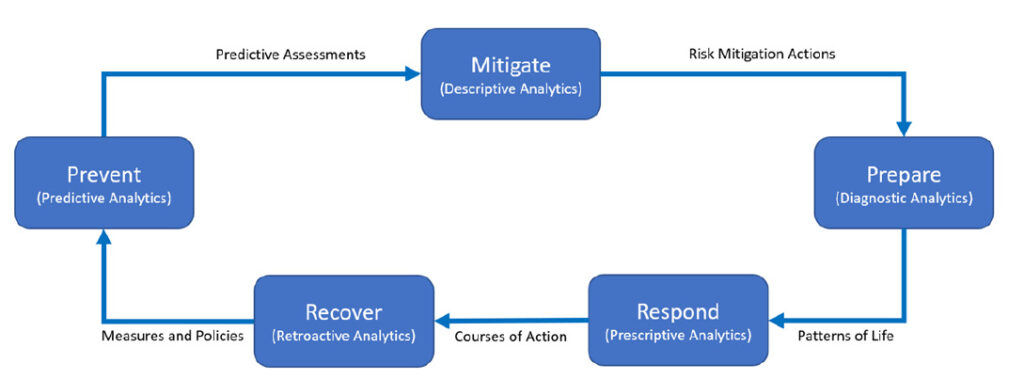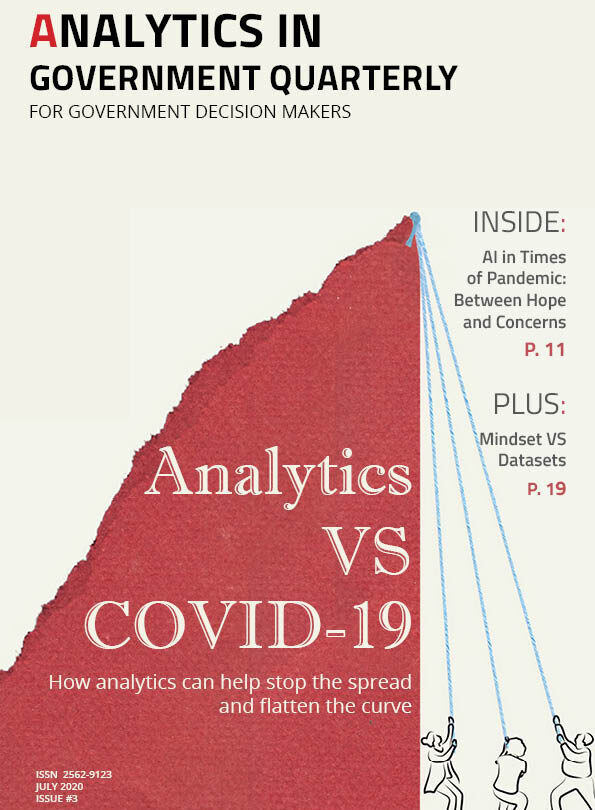DASHBOARD
Analytical Emergency Management
How to leverage the Analytical Emergency Management framework to manage emergency situation
By Rami Abielmona, Ph.D.

An Emergency Situation
Imagine a mass gathering for a planned protest is being held in a major North American city near downtown buildings and the surrounding streets. Both municipal and law enforcement planning has been completed, and officers have been briefed and assigned positions. A manned helicopter has been stationed for overhead surveillance. Road closures along the planned route are in place and the population has been notified of the protest to control traffic and bystanders. A command post is established and is receiving information from officer radios, network chat as well as video and imagery from surveillance aircraft and officers in the field. Incoming data is digitized, analyzed, and displayed on the command centre’s Artificial Intelligence and Machine Learning (AI/ML) enabled Common Operating Picture (COP). Monitoring of open source, Twitter, Instagram and weather reports is established, while the location and the open source messages are displayed on the COP.
At a certain moment, a disturbance occurs in the crowd caused by a person (e.g., running through the crowd) or a group intending to infiltrate the mass gathering in an attempt to transform the demonstration into a violent event. What transpires next is quite disorderly: the situation devolves rapidly when surprise transforms into chaos and a vast amount of data begins to be transmitted from multiple sources and soon overwhelms the command centre’s ability to weed out the noise and focus on what is relevant. Important questions have be to be answered in a rapid and focused manner: which of the data points carry useful information, what can be safely ignored for now, what is the most optimal way of redeploying assets and what information services can be called upon to deescalate the situation and maintain order and control?
Using a data-oriented architecture and Big Data Analytics (BDA), the perpetrators can be detected through image and video analytics from the pre-positioned static Electro-Optical (EO) / Infrared (IR) camera sensors as well as Full Motion Video (FMV) and thermal sensors on board aerial assets (e.g., helicopters, UAVs). These are processed using image and video analytics to produce indicator tracks focusing on the perpetrators and helping commanders weed out the noise. The suspects can then be tracked and classified using decision-support system software that provides ML-based anomaly detection identifying the suspects as being anomalous to the background scene (i.e., the mass demonstration). This subject anomaly can be due to their speed, shape, movement, behaviour and overall pattern-of-life (POL) which has been detected as being substantially different from the norm (e.g., a group of people moving in the opposite direction of the crowd, a person intersecting through the demonstration, a group of people congregating together and moving within the crowd).
Retroactive Analytical Scheme
From an analytics standpoint, emergency management requires the adoption of all four known types of analytics (described below), in addition to retroactive analytics as a fifth analytic type. A retroactive analytical scheme allows an autonomous system to learn over time, solving the short-term view of reactive systems, and to respond in real-time to world events, solving the calculative rationality of proactive systems. This can also be used to provide recommendations to better prepare for future situations by modeling and simulating the possibilities in a retroactive manner. This affords for better intelligence assessment and therefore mission planning, through understanding what could have happened, and how it could have unfolded within an emergency situation. Here is a brief description of each analytic below:
Descriptive Analytics: answers the question of “What happened?” by extracting spatiotemporal information and fusing (i.e., correlating) multiple data sets and sources to provide insights into the past. This will allow for exploration into the past and discovery of exactly how these emergency events and situations transpired;
Diagnostic Analytics: answers the question of “Why something happened?” by data-drilling and POL recognition to provide insights into the present. This will allow authorities to explore the present and identify why emergency events and situations evolve in a certain manner;
Predictive Analytics: predicts “hat will most likely happen” by learning past and current tendencies and forecasting future trends (i.e., through models of potential outcomes). This will strengthen the preparedness capabilities by allowing authorities to explore the future and identify how emergency events and situations most likely will evolve;
Prescriptive Analytics: answers the question of “What should be done?” by running multi-objective optimization (MOO) within a modeling and simulation environment to provide recommended responses to better deal with the future. This will strengthen the mission-critical capabilities by allowing authorities to explore the various courses of action while attempting to mitigate future emergency risks or take advantage of promising trends; and
Retroactive Analytics answers the question of “What could have been done?” by scenario and mission planning through modeling and simulation, in order to provide recommendations to better prepare for similar emergency situations in the future. This will strengthen the decision-making capabilities by allowing the authorities to retroactively explore the past and figure out how to better deal with emergency situations in the future.
Analytical Emergency Management

Authorities need to make accurate, timely and rapid decisions at different stages of the emergency management spectrum within a complex and information intensive environment. This five-step process, called Analytical Emergency Management (AEM), typically involves various trends, transitions and tempos while mapping quite suitably to the above BDA. As we can see from the below figure representing the closed loop AEM cycle, officials initially need to be able to prevent emergency situations by predicting them through historical training of models using predictive analytics. If an event actually transpires or a situation develops, officials need to be able to mitigate the situation by rapidly detecting it and making rapid decisions for adapting to, eliminating and reducing the risks to the human population using descriptive analytics. As the situation unfolds, a near real-time, accurate picture is required as to the cues and patterns required to prepare to respond to the emergency and manage its consequences through diagnostic analytics. Subsequently, as the emergency situation evolves (devolves), officials need to actively respond to the situation and support decisions about how to allocate limited and/or secure additional resources are to be taken through prescriptive analytics. Finally, when the situation comes to an end, mitigation and response measures, as well as policies, are analyzed to quickly recover from the emergency and restore conditions to an acceptable level, all the while analyzing and implementing lessons learned and improving first responder training through retroactive analytics.
AI-Powered AEM
AI/ML finds itself embedded throughout the AEM cycle. Whether it is the optimal placement and rapid redeployment of assets (such as law enforcement vehicles) and sensors (such as first responder imagery), as well as the real-time exploitation of data sources (such as social media feeds), or the automated path planning for all platforms and on-board sensors as well as the AI-based response generation for the various first responder assets (e.g., fire, EMS, etc.) provides an optimal Course of Action (COA) for the emergency response, AI/ML is a driving factor for each facet of AEM.
An AI-powered AEM cycle within an emergency management environment is essential for the efficient protection and overall safety of the population and first responders alike. The smart COP provides an efficient multi-sensor solution for the highly demanding situational assessment performed during the AEM cycle. The persistent real-time optimized situational picture provides the decision maker with a host of intelligence products with which to make an informed decision in a time critical fashion for an effective mitigation of a rapidly developing situation. AI/ML approaches are thus required to cope with the vast quantity of sensor data that are to be exploited and to provide optimized recommendations to first responders. This concept also allows for the integration of incidence policies, emerging communications sources, radio and other location-based services, open/closed source and specific responder communication services and, based on all of this information, optimizes, presents risk factors and recommends COAs to incidence commanders through the AI-powered COP.
AEM provides the opportunity to integrate AI/ML into a multi-layer analytical framework, moving away from user-centric solutions to ones that are more autonomous in nature and deployable across a variety of responder domains (e.g., fire, police, search-and-rescue, health, etc.). It is obvious that, with the recent increase in mass public disturbances and emergencies coupled with the advent of BDA and the proliferation of AI/ML capabilities, emergency management has to evolve, in the very near future, to become more analytical, asymmetric and adaptive. Our safety and security would greatly benefit from that.
About The Author

Rami Abielmona, Ph.D., P.Eng., SMIEE
Rami is the Vice President of Research & Engineering at Larus Technologies Corporation and is responsible for all research and development of software, hardware and products, as well as the management and direction of the research team. He was one of the recipients of the Ottawa Business Journal (OBJ) Top 40 Under 40 Award in 2011, was named as the Part-Time Professor of the Year at both the Faculty of Engineering and the University of Ottawa in 2012 and was a recipient of the NSERC Synergy Award for Innovation (for Small and Medium-Sized Companies) in 2016.

